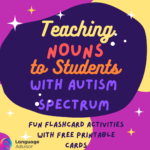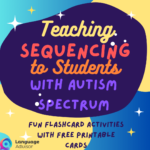Teaching Phonics and Letters to Students with Autism Spectrum: Engaging Flashcard Activities and Free Printable Flashcards
Teaching Phonics and Letters to Students with Autism Spectrum

Teaching Phonics and Letters to Students with Autism Spectrum
Learning phonics and letters is an important step in building early reading and language skills. For students on the autism spectrum, using visual aids like flashcards can make phonics more accessible and enjoyable. Flashcards provide a focused and hands-on way to practice letter sounds, letter recognition, and early word formation.
In this blog post, we’ll explore fun ways to use flashcards to teach phonics and letters to students with autism. Plus, you can download free printable phonics and letter flashcards at the end of this post to start using in your classroom or at home.

Why Are Phonics and Letter Recognition Important?
Phonics involves teaching students the relationship between letters and their sounds. Understanding phonics helps students:
- Develop reading skills: Recognizing letters and their sounds is the foundation for decoding words and beginning to read.
- Improve language and communication: Learning letters and sounds expands vocabulary and helps with forming words.
- Build confidence: Mastering phonics helps students feel more capable and independent in their reading and writing abilities.
For students with autism, structured, visual learning tools like flashcards can be especially helpful for staying focused and engaged.y effective, as many students on the spectrum are visual learners.
Fun Activities Using Phonics and Letter Flashcards
Below are some interactive ways to use these flashcards in your lessons:
1. Letter-Sound Matching
Hold up a letter flashcard (for example, “A”) and say the letter’s sound: “A says ‘ah’.” Then, show the student an object or picture that starts with that letter sound (e.g., an apple for “A”). Ask the student to match the sound with the correct flashcard.
Tip: You can use real-life objects like toys or food items to make this activity even more engaging.
2. Alphabet Scavenger Hunt
After introducing a few letters, use the flashcards to play an alphabet scavenger hunt. Show a letter flashcard and ask the student to find something in the room that starts with that letter sound. For example, if you show the letter “B,” they might find a ball.
Tip: Start with simple objects that are familiar to the student and gradually introduce new vocabulary as they become more comfortable with the sounds.
3. Sound Sorting
Create a sorting activity by laying out several flashcards. Then, provide a group of objects or images and ask the student to sort them by their beginning sounds. For example, sort pictures of apples, bananas, and cars under the correct flashcards for A, B, and C.
Tip: Keep the activity simple by limiting it to three or four letter sounds at first, then increase the challenge as the student progresses.
4. Flashcard Letter Tracing
Combine phonics practice with fine motor skill development by having students trace the letters on the flashcards. This helps reinforce letter recognition while building hand-eye coordination for writing.
Tip: Use different colors to make tracing more fun, or provide tactile letters for added sensory input.
5. I Spy with Letter Sounds
Using the flashcards, play a version of “I Spy” with letter sounds. Hold up a flashcard and say, “I spy something that starts with the letter B!” Encourage the student to find an object or picture that begins with that sound.
Tip: This is a great activity for outdoor exploration too—use it during nature walks or on a playground to keep things exciting!
6. Phonics Memory Game
Place the letter flashcards face down and take turns flipping them over to find matching pairs. When the student finds a pair, have them say the sound the letter makes and name an object or animal that starts with that sound.
Tip: To make the game easier, start with just a few pairs of letters and gradually add more as the student gains confidence.
7. Build Simple Words
Once the student has mastered a few letters and sounds, use the flashcards to begin building simple words. For example, lay out the flashcards for C, A, and T, and help the student sound out the word “cat.” This is a great way to introduce early reading in a hands-on way.
Tip: Start with short vowel words (CVC words) like “cat,” “dog,” or “bat” for easier blending of sounds.

How to Use These Activities
Here are some tips to make phonics and letter learning effective and enjoyable:
- Start slow and build confidence: Focus on one or two letters at a time before introducing more.
- Make it visual and hands-on: Use real objects, pictures, and tracing to make learning more interactive.
- Repetition is key: Revisit letters and sounds frequently to help students retain what they’ve learned.
- Celebrate successes: Encourage students with praise for each step forward, whether it’s recognizing a letter or sounding out a word.
Final Thoughts
Teaching phonics and letters to students with autism doesn’t have to be overwhelming. Using flashcards can make learning interactive, engaging, and fun. These activities help students develop early reading skills, build confidence, and create positive learning experiences.
Don’t forget to download the free phonics flashcards to start teaching your students today!
Let us know how these activities worked for your class and feel free to share any success stories in the comments below!

Teaching Phonics and Letters to Students with Autism Spectrum
DOWNLOAD THE PDF FOR FREE





